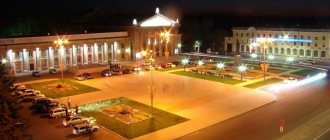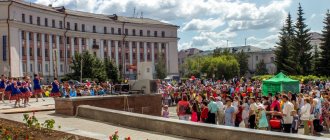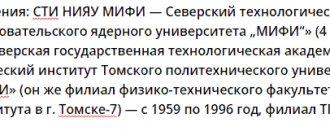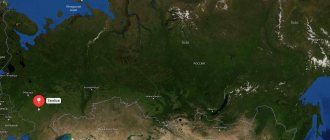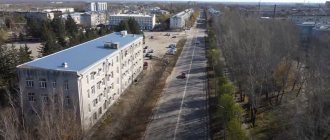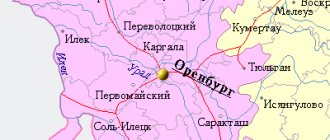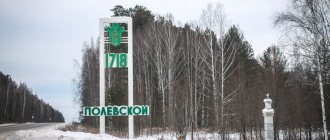There are many small towns in Russia with a long and interesting history, and the city of Buzuluk can be counted among them.
The city was founded in 1736, 150 Cossacks served and lived in it at that time, but currently Buzuluk has up to 86 thousand inhabitants.
The expedition led by Ivan Kirillovich Kirillov (geographer, historian, statesman) founded a number of fortresses, including on the left tributary of the Samara , on the Buzuluk . The fortresses were supposed to secure the southeastern borders from raids by nomads and protect the road to Orenburg.
The Buzuluk fortress was surrounded by a large rampart, surrounded by a moat and had log walls on which cannons were placed on top. It was built of wood, and the fire of 1785 destroyed almost the entire city. After this, the fortress was not restored, the city was not surrounded, and the ditch was filled up.
The city is rich in attractions.
Water tower
It is located near the pedagogical college, on Lenin, 67. Made in the same pseudo-Gothic style and designed by the same architect. Date of construction: 1905.
photo from the site: 7 wonders of Buzuluk
In the city center, at the intersection of Yarosha and Chapaeva streets, there is another building with an interesting facade, built of red brick. This is the former Men's Real School.
Etymology
The fortress was named after the Samara tributary river on which it was built. Buzuluk is a fairly common name in the steppe regions where Turkic tribes roamed. Rivers of the same name flow in the Volgograd and Dnepropetrovsk regions.
Comes from the ancient Turkic toponym “buzuluk”, which translates as “ice”. Usually nomadic tribes called this small rivers that fill only in the spring, when the snow and ice melt. In Crimea there is a Buzuluk cave, the bottom of which is covered with non-melting ice. The name is translated from Crimean Tatar as “glacier” or “accumulation of ice.”
There is another version - that Buzuluk comes from the Tatar “bozau” - “calf” or “bozaulyk” - “veal fence”. According to this hypothesis, the place where the river flows into Samara is very convenient for grazing calves. According to another alternative version, the name of the city was given by the Turkic tribe Buzu or Base, which translates as “rebellious” and “rebellious”.
Men's real school.
The building was built in 1911. A.S. Pushkin stayed there, during the Soviet years there was a school, and during the Great Patriotic War there was an evacuation hospital.
photo from the site: 7 wonders of Buzuluk
The local history museum on Lenina, 56 participates in the all-Russian “Night of Museums” program; photo exhibitions are also held here.
Buzuluk on the map of Russia, geography, nature and climate
On the map of Russia, Buzuluk can be found northwest of the regional center and southeast of Samara.
The city is located at the picturesque confluence of the Samara , Domashka and Buzuluk .
The nature of the area is atypical for southern latitudes: steppe vegetation neighbors the Buzuluksky forest, the southernmost natural coniferous forest in Russia.
The climate is sharply continental: winters are harsh and long; summer is hot, dry, but short-lived.
The building of the former Zemstvo Government.
The façade of the building is made in the pompous Russian Art Nouveau style and is undoubtedly a decoration of the city. It is believed that the building was built by captured Austrians, who were given freedom and secretly (unofficially) sent to their homeland. In 1917, it hosted the district congress of workers and peasants' deputies; during the Great Patriotic War, the headquarters of the armed forces of the Polish Republic (Anders' Army) was located. Nowadays, an industrial and pedagogical college has settled here.
photo from the site: 7 wonders of Buzuluk
Address: st. May 1, 35.
City of Buzuluk (Orenburg region)
Cathedral Square in Buzuluk
Buzuluk is a city in the western part of the Orenburg region, the administrative center of the Buzuluk district, the railway station of the same name on the South Ural road on the Kinel - Orenburg line. Located on the rivers Samara, Buzuluk and Domashka, 252 km northwest of Orenburg and 172 km southeast of Samara, 100 km south of Buguruslan, 90 km northwest of Sorochinsk. Population - 86,042 people. (2021).
From 1851 to 1928 Buzuluk was part of the Samara province. Until 1934, the city was part of the Samara province and the Middle Volga region. Since 1934, Buzuluk has been part of the Orenburg region (from 1938 to 1957 - Chkalov region).
Fifteen kilometers north of the city is the Buzuluksky Bor National Park. On the northwestern outskirts of the city there is a sports airfield.
The water tower built in 1905 is one of the symbols of Buzuluk
Brief history of the Buzuluk fortress and the city of Buzuluk
In the spring and summer of 1736, the Orenburg expedition led by the Chief Secretary of the Senate I.K. Kirilov founded a number of fortresses along the Samara River, including Buzulutskaya. “The Buzulutsk fortress is 18 versts from Olshanskaya, and 255 versts from Orenburg, its name comes from the Buzuluka river, which flows into Samara.” The Buzuluk fortress is named after the Buzuluk River, a tributary of the Samara. The name came from the ancient Turkic “buzuluk”, which means “ice” (this is how small rivers were characterized, which were full only when the snow melted).
Buzuluk. Market Square, Trinity Cathedral and Water Tower
The original location for the fortress near the mouth of the Buzuluk River turned out to be inconvenient - the spring flood cut it off from the surrounding area. Therefore, the fortification was moved to a higher place near the Domashka River and Lake Banny. The fortress had a circumference of 800 fathoms, the first settlers were 478 Yaik Cossacks, 19 Nogais, 12 Kalmyks and 47 “people of various ranks, some exiled”
According to P.I. Rychkova, “the inhabitants of the fortress are content with the pine forest, where there are many moose. In addition, there is good land for arable farming and they produce more grain than others.” According to the decree of 1781 on the establishment of the Ufa governorate, the Buzulut fortress received the status of a district town and became the center of the Buzuluk district.
Buzuluk. Holy Trinity Convent
In 1811, 1,000 people lived in the city, and in 1897 - 14,471 people. Three fairs were held annually in Buzuluk. There was a bell factory. In the city there were the Bogoroditsky women's and Spaso-Preobrazhensky men's monasteries, 5 churches, a city three-class men's and three-class women's schools, as well as 2 parish schools.
On September 17, 1833, A.S. stayed in Buzuluk. Pushkin, who spoke about the last battle of the defenders of the Buzuluk fortress (in 1936, the city garden was renamed the city park named after A.S. Pushkin, in honor of the Russian poet)..
Buzuluk, Tikhvin Convent
Features of Buzuluk in the 19th century. - a wealth of Orthodox churches and monastic buildings. Thus, within the city limits there were: Alexander Nevsky Church built in 1838, St. Nicholas Church built in 1858, St. Nicholas Church at the Buzuluk station built in 1908, Intercession Church (1864), Trinity Cathedral (1847). At the Buzuluk Spaso-Preobrazhensky Monastery there was the Kazan Cathedral built in 1861, the Transfiguration Church (1869), a bell tower (1867), St. Nicholas Church (1882), the Sorrow Church (1903), a chapel and an abbot's building (1879), Brethren's building (1865), refectory and postal buildings (1866). At the Buzuluk Tikhvin Convent there were the Church of the Tikhvin Icon of the Mother of God (1861), the Trinity Church (1848) and the bell tower (1891), as well as a parish school built in 1897 and numerous clergy buildings.
In the 19th century a monastery appeared next to Buzuluk near the legendary Ataman Mountain (before that, the monks lived here in caves). The underground monastery in 1853 was turned into the Spaso-Preobrazhensky Buzuluk Monastery. Here was a copy of the miraculous icon of the Mother of God “Joy of All Who Sorrow,” which was the main monastery shrine.
The monastery played an important role in the life of the inhabitants of the Samara Trans-Volga region and the Southern Urals. Several temples were erected on its territory - the Kazan Cathedral (1861), the temple in the name of St. Nicholas the Wonderworker, then the chapel of the icon of the Mother of God “Life-Giving Spring”. In 1903, a temple of the icon of the Mother of God “Joy of All Who Sorrow” was built on the caves. Every year, the monastery was visited by several tens of thousands of pilgrims, ranging from governors, representatives of the nobility, intelligentsia and ending with peasants who flocked here for holidays. In 1873, the writer Lev Nikolaevich Tolstoy visited here to communicate with the elders (this moment in the writer’s life was reflected in correspondence).
Buzuluk railway station
Zemstvo government building
The largest building in the city, the government building, according to legend, was built according to the design of captured Austrians, for which the head of the city promised them freedom. At the end of construction, he kept his word: the Austrians were recorded as dead and staged a fake funeral service, and then sent home. In 1917, the first district congress of the Soviets of Workers', Peasants' and Soldiers' Deputies was held here. During the Great Patriotic War, the building housed the headquarters of the Polish Anders Army (now the Industrial Pedagogical College).
The first bus in Buzuluk, 1930
Steam locomotives released from repair for the May Day holidays. Buzuluk depot, 1931
Buzuluk during the Great Patriotic War. Formation of the Polish "Anders' Army"
During the Great Patriotic War, five industrial enterprises were evacuated from the western regions to Buzuluk. Three divisions of the Red Army, the First Separate Czechoslovak Battalion of Ludwik Svoboda and the Polish Army of General Wladyslaw Anders were formed here. In 1941, the archive of the People's Commissariat of Defense of the USSR (now the Central Archive of the Ministry of Defense of the Russian Federation) was evacuated to Buzuluk.
On July 11, 1941, at a meeting in London, the USSR Ambassador to Great Britain I.M. Maisky, British Foreign Minister Eden and Polish Prime Minister W. Sikorski reached an agreement on the creation of a Polish army in the USSR, operationally subordinate to the Supreme Command of the USSR. A protocol was adopted according to which the Soviet government granted amnesty to 381 thousand Polish citizens held in custody. On the basis of the Polish-Soviet agreement, an army was formed from the released prisoners for military operations against Germany. General Vladislav Anders was appointed to the post of army commander.
The size of the “Anders army” was determined to be 30 thousand military personnel. The USSR government provided weapons, and Great Britain supplied British-style uniforms for personnel. The formation of the Polish army began after August 23, 1941, when the Soviet-Polish conscription commissions arrived at the prisoner of war camps. On September 2-6, most of the Poles were sent to form in Buzuluk, as well as Tatishchevo and Totsk. By September 12, 24,828 former prisoners of war arrived there. By October 1, 16,647 Poles released from prisons, camps and special settlements were added to them, and later another 10 thousand people.
Divisions were gradually formed from them, which, as they were recruited, began training. However, General Andres constantly made statements that the Germans would capture Moscow and cross the Volga, and therefore the Poles should be sent south, to Turkmenistan and Uzbekistan, so that from there the army would go to Iran to the British and fight the Germans under English banners. In November 1941, the governments of the USSR and Poland signed a declaration in which the government of V. Sikorsky confirmed its commitment to “wage war against German bandits hand in hand with Soviet troops.” An agreement was reached to increase the total strength of the Polish army in the USSR from 30 thousand to 96 thousand people.
Review of Polish units of Anders' army in Buzuluk, December 1941.
At the beginning of 1942, the USSR persistently began to demand that trained Polish divisions be sent to the front, but the Poles refused. Since September 1941, they have been negotiating with the British on how to leave the territory of the USSR for Iran.
As a result, it became clear that the Poles would not fulfill their obligations. The gradual transfer of Poles to Iran began. The price of agreements with the Polish government turned out to be zero. In a note dated October 31, 1942, sent to the exile government, the USSR government stated that it had done everything in its power to fulfill the agreements concluded, “to unite the efforts of the Soviet and Polish peoples in a joint struggle against Hitler’s robbers and occupiers... The Polish government took a different path "
The building of the Central Regional Hospital at the intersection of the street. Rozhkov and Pushkin built in 1957
Since the 1960s The development of the Buzuluk oil fields began. After Buzuluk oil entered the international market via the Druzhba main oil pipeline in 1973, the city began to be called the oil capital of the Orenburg region.
In 2005, Buzuluk became the best municipal entity in the Orenburg region in terms of economic development indicators, and in September 2005 it was recognized as the winner of the 4th All-Russian competition for economic development “Golden Ruble” in the Volga Federal District in the “Medium City” category. Among the enterprises of the city, the Buzuluk Mechanical Plant stood out - a machine-building enterprise in the Western Orenburg region, producing a wide range of cooling radiators and heat exchangers, as well as tractor, special and agricultural equipment based on MTZ Belarus tractors.
In the last decade, the economic situation in the city has been characterized by major problems in the industrial sector. A furniture factory is closed, two machine-building plants have gone bankrupt, and oil production at oil and gas industry enterprises is falling.
St. Tikhvin Convent
The first monastery built in the Orenburg region, built in 1857, received official status in 1859. By 1890, the number of buildings in it increased - there were already economic services, several churches, and fences.
photo from the site: 7 wonders of Buzuluk
Like many other churches, in 1920 the monastery was looted and destroyed. Then the religious buildings were used for various needs. In one of the temples of the complex there was a power plant, in the 30s there was a transit prison, and at the end of the last century there was an energy enterprise. At the turn of the 20th–21st centuries, the temple complex began to be restored. The main shrines of the monastery, which you can familiarize yourself with, are the Tikhvin Icon of the Mother of God and the icon of St. Seraphim of Sarov with a particle of his relics.
Address: Buzuluk, st. Sergo, 1.
Cathedral of St. Nicholas the Wonderworker
Years of construction: 1908–1910. Located near the railway station. The temple is very beautiful, but it is not authentic - it is a restored building, since it was partially destroyed in the 30s. Since 1990, the cathedral has been reopened to believers.
photo from the site: 7 wonders of Buzuluk
Address: Cathedral of St. Nicholas Myra of Lycian Wonderworker in Buzuluk
461040, Orenburg region, Buzuluk, st. 1st line, no. 57
temple: 8 (353-42) 5-04-04; 8 (353-42) 5-04-54
Routes on the map of Buzuluk. Transport infrastructure
The Buzuluka railway station was built on the route of trains from Orenburg to Kinel along the South Ural Road.
P224 highway .
The regional highway P246 , connecting Bugulma and Uralsk.
There are two main types of public transport within the city: buses and minibuses. They connect residential neighborhoods with socially significant facilities.
